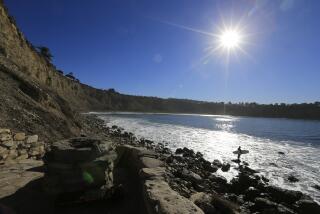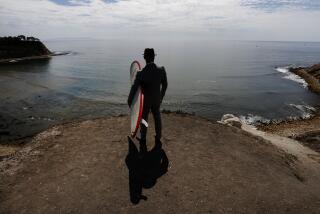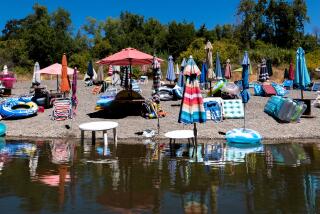Nascent Gangsterism Gets a Tough Look at Newport
- Share via
NEWPORT BEACH — The flyer found in a Pomona high school looked like an innocuous party invitation.
“Beach Bash ‘93” declared the heading.
“B.Y.O.S.,” was splashed across the bottom, telling would-be revelers to bring their own spray paint. The party--sponsored by the viKING$, a tagging crew well-known to local police--had a fashionable address: the Newport Beach pier.
As graffiti and other gang-related crimes continue to plague urban areas of Southern California, even affluent, safe, pristine communities such as Newport Beach are not immune, city officials say. Though there are no resident gangs in the coastal city, police say, the thousands of tourists who flock to its beaches include gang members from Orange, Los Angeles, Riverside, San Bernardino and San Diego counties.
“Gangs from all over Southern California come to the beach, meet, and do whatever they want to do,” said Sgt. Mike McDermott, who heads the city’s gang detail. “We get kind of the backwash down here.”
City leaders admit that their gang troubles pale in comparison to their fiscal woes--not to mention recent sex and embezzlement scandals--and that the real gang problem lies elsewhere in the county.
But they refuse to wait for the problem to blossom.
The police this year began to track gang-related crimes; the City Council is weighing an anti-graffiti ordinance along with the idea of erecting gates to keep unwanted people out certain neighborhoods at night; and today is the first meeting of the city’s gang task force.
“It’s probably our biggest problem right now on the street, because everything’s tied into it,” acting Police Chief Jim Jacobs said of gangs.
“Our problem, compared to Santa Ana, or Westminster, or Stanton, it’s minuscule,” Jacobs admitted. “We want to keep it that way.”
Some residents, though, say the city is not so much reacting to the community’s fear of gangs as creating it.
“I have read about the . . . gangs coming into here, but as for problems, I haven’t seen it,” said Kenny Clark, 30, who lives a few blocks from the beach. “During summer things get pretty wild, but it’s mostly just kids partying.”
“They don’t want kids driving away the tourists,” added Erin Kelly, a UC Irvine student whose beachfront apartment overlooks Newport Pier. “I think it’s the Newport Beach image thing.”
In a county where police have identified 15,000 gang members, Newport Beach has only 12, McDermott said.
Last month, Newport Beach officers--who routinely question youths whose attire fit a gang profile--stopped 58 people who were later identified as gang members through a countywide computer network. There were 13 gang-related crimes, including a car burglary, two auto thefts, eight graffiti or vandalism incidents and two cases of alcohol-connected offenses; but no violent crimes.
In addition, six known gang members were arrested in Newport Beach in March, two on warrants and four for providing false information to police.
And, tipped off by the Pomona police to the viKING$ “Beach Bash” flyer, which was printed in English and Spanish, Newport Beach officers intercepted about seven carloads of teen-agers headed to the beach apparently for a graffiti fest, McDermott said.
“Ditch days” and tagging parties, like those advertised in the Pomona flyer, are common problems on the beach, he said, adding that officers routinely find carloads of teen-agers in beach parking lots on school days and that the city’s two piers and the rocks at Corona del Mar State Beach are slapped with graffiti most weekends. “It’s definitely not anything that’s out of hand, it’s just that it affects the quality of life. People see that type of thing and they associate it with the problems of the inner-city,” said McDermott, who has been with the Newport force for 13 years. “People are concerned about it. No question about it. . . . They don’t want this to turn into South-Central L.A.”
While many cities are awash in daily doses of violence, discussions of gang activity in Newport Beach inevitably hark back to a few isolated incidents. There were 42 gang-related homicides in Orange County in 1992--the last such killing in Newport Beach happened four years ago.
More recently, racial tangles have erupted at city schools.
Several students suspected of belonging to a white supremacist group were expelled from Corona del Mar High School in January after a confrontation with some black students from Tustin during a basketball game. Last November, a fight between whites and Latinos at Ensign Intermediate School in Newport Beach ended with a pencil-stabbing. Police believe that it was gang related.
Because Newport Beach shares a school system with Costa Mesa, where police identify four gangs, teachers and administrators fear that more gang activity will visit the campuses. Many are worried about the impending rezoning that will send some residents of a Costa Mesa gang-involved neighborhood to Newport Harbor High School next year.
“All you have to do is pick up the newspaper, watch television or observe some of the events happening on our streets and in our schools, in our county and state to know this isn’t a localized problem,” said Tom Jacobson, principal at Corona del Mar High. “Anybody who isn’t concerned about it ought to be concerned about it wherever they are.”
At its first meeting today, the gang task force will study other cities’ efforts to combat gangs. The panel will consider tougher law enforcement measures to curb out-of-town gang activity on the beaches, as well as educational programs designed to keep local students from joining gangs.
“It’s not something that we have to live in fear and trembling of, but I do think we have to be realistic and confront what could be a problem in the future,” said Councilman John W. Hedges, who spearheaded the move for a task force and will chair the five-member group. “I believe in planning ahead.”
City, school and police officials say their growing concern over gangs stems from residents’ fears, as well as reports of graffiti and other crime in city neighborhoods and beach areas.
But those who live at the beach say they have witnessed little or no gang activity, and that, in some cases, police overreact in their anti-gang stance.
“The police are everywhere,” agreed Nancy McBride, manager of a restaurant on the Balboa Peninsula. “There is more concern (about gangs) than there should be.”
“I have seen groups of kids running around on the beach late night wearing black jackets,” said UCI student Kelly. “They didn’t look like they were looking for a crime; they looked bored.”
“There is not much for them to do. The cops are all around,” said Charlie Blankenheim, one of Kelly’s five roommates. “I saw six cops giving a kid who was about 12 years old a ticket for skateboarding. . . . They had the poor guy surrounded.”
Chuck Gonzales, the manager of the Fisherman’s Galley, said he has been attacked by knife-wielding drunks several times over the past year but has never witnessed a gang fight. “I think (city officials) have blown the problem up,” Gonzales said. “People wouldn’t be so worried if they would let it go to the back of people’s minds.”
McDermott acknowledged that Newport Beach’s gang problem remains small but denied that police are exaggerating the issue or stopping teen-agers unnecessarily.
As they prepare for the onslaught of summer tourists, the department hopes to send the message to gang members across the region that Newport Beach is not a good place to start trouble.
“Some people see any graffiti at all and they’re convinced that their neighborhood is being taken over by the Crips and the Bloods . . . that’s not the case,” McDermott said.
“Other people just ignore the problem, they figure they’re living in Newport Beach, there’s a gate at the east end of the city and the west end of the city, and gang members don’t have the access codes. That’s not true, either.”
More to Read
Sign up for Essential California
The most important California stories and recommendations in your inbox every morning.
You may occasionally receive promotional content from the Los Angeles Times.










